2009 FORD SUPER DUTY warning lights
[x] Cancel search: warning lightsPage 136 of 418
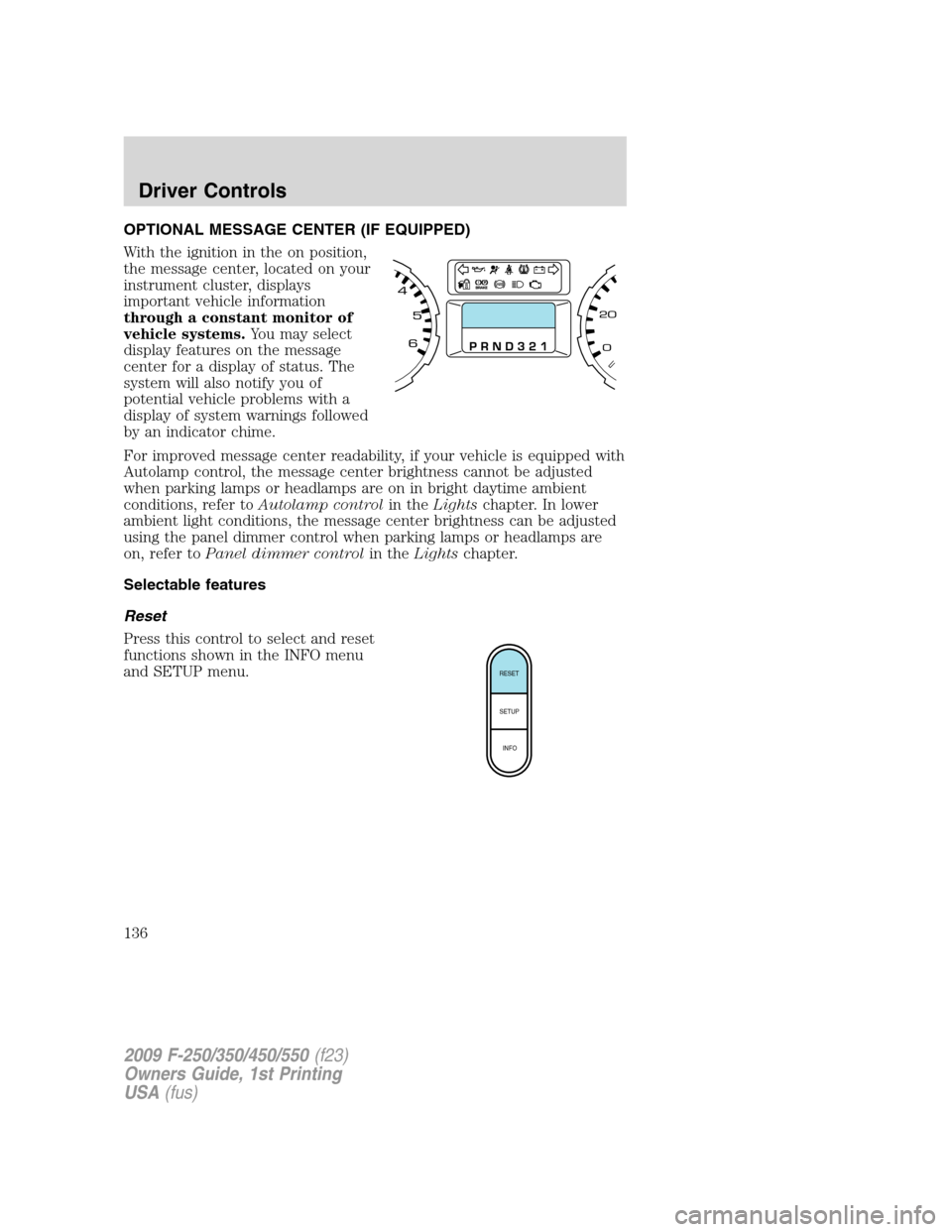
OPTIONAL MESSAGE CENTER (IF EQUIPPED)
With the ignition in the on position,
the message center, located on your
instrument cluster, displays
important vehicle information
through a constant monitor of
vehicle systems.You may select
display features on the message
center for a display of status. The
system will also notify you of
potential vehicle problems with a
display of system warnings followed
by an indicator chime.
For improved message center readability, if your vehicle is equipped with
Autolamp control, the message center brightness cannot be adjusted
when parking lamps or headlamps are on in bright daytime ambient
conditions, refer toAutolamp controlin theLightschapter. In lower
ambient light conditions, the message center brightness can be adjusted
using the panel dimmer control when parking lamps or headlamps are
on, refer toPanel dimmer controlin theLightschapter.
Selectable features
Reset
Press this control to select and reset
functions shown in the INFO menu
and SETUP menu.
RESET
SETUP
INFO
2009 F-250/350/450/550(f23)
Owners Guide, 1st Printing
USA(fus)
Driver Controls
136
Page 246 of 418
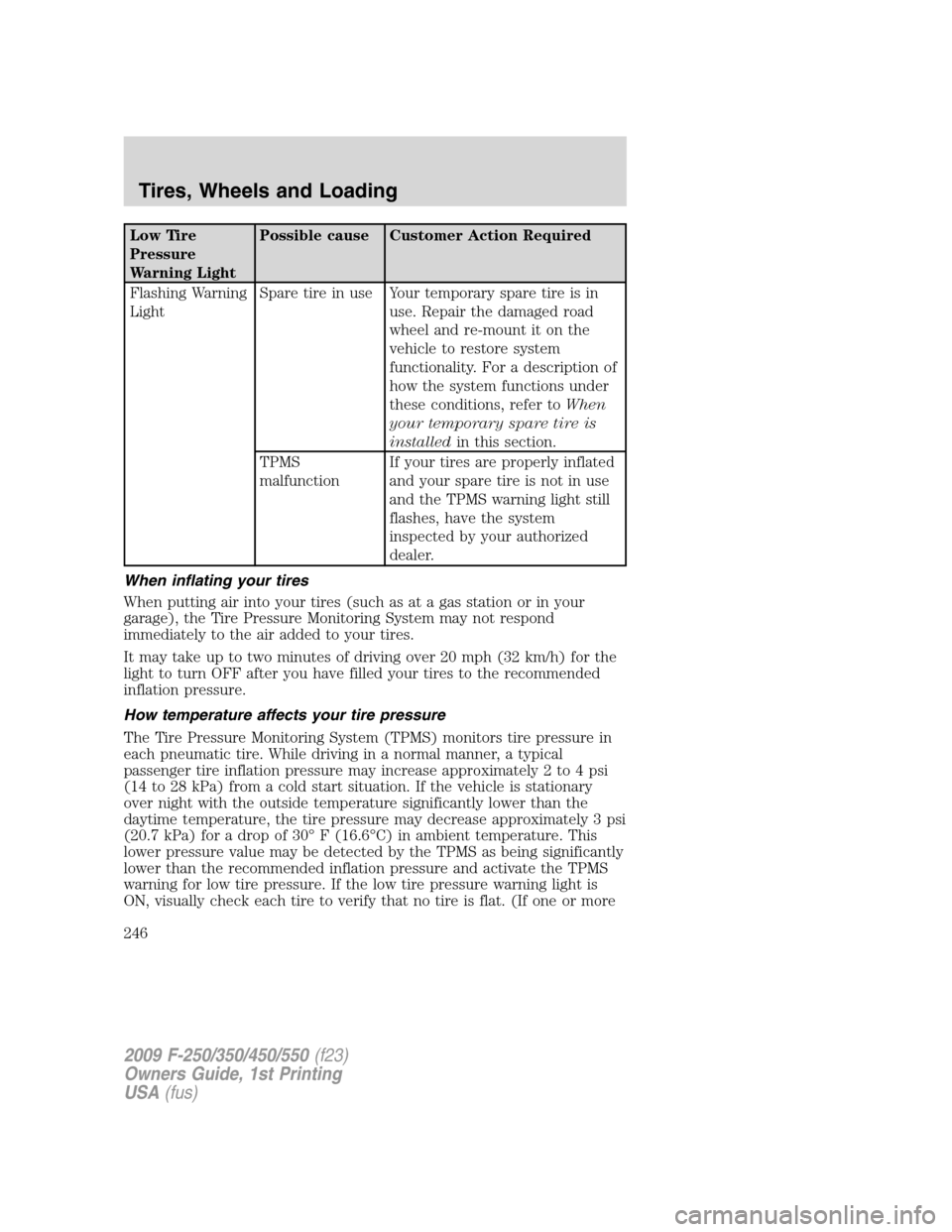
Low Tire
Pressure
Warning LightPossible cause Customer Action Required
Flashing Warning
LightSpare tire in use Your temporary spare tire is in
use. Repair the damaged road
wheel and re-mount it on the
vehicle to restore system
functionality. For a description of
how the system functions under
these conditions, refer toWhen
your temporary spare tire is
installedin this section.
TPMS
malfunctionIf your tires are properly inflated
and your spare tire is not in use
and the TPMS warning light still
flashes, have the system
inspected by your authorized
dealer.
When inflating your tires
When putting air into your tires (such as at a gas station or in your
garage), the Tire Pressure Monitoring System may not respond
immediately to the air added to your tires.
It may take up to two minutes of driving over 20 mph (32 km/h) for the
light to turn OFF after you have filled your tires to the recommended
inflation pressure.
How temperature affects your tire pressure
The Tire Pressure Monitoring System (TPMS) monitors tire pressure in
each pneumatic tire. While driving in a normal manner, a typical
passenger tire inflation pressure may increase approximately 2 to 4 psi
(14 to 28 kPa) from a cold start situation. If the vehicle is stationary
over night with the outside temperature significantly lower than the
daytime temperature, the tire pressure may decrease approximately 3 psi
(20.7 kPa) for a drop of 30° F (16.6°C) in ambient temperature. This
lower pressure value may be detected by the TPMS as being significantly
lower than the recommended inflation pressure and activate the TPMS
warning for low tire pressure. If the low tire pressure warning light is
ON, visually check each tire to verify that no tire is flat. (If one or more
2009 F-250/350/450/550(f23)
Owners Guide, 1st Printing
USA(fus)
Tires, Wheels and Loading
246
Page 272 of 418
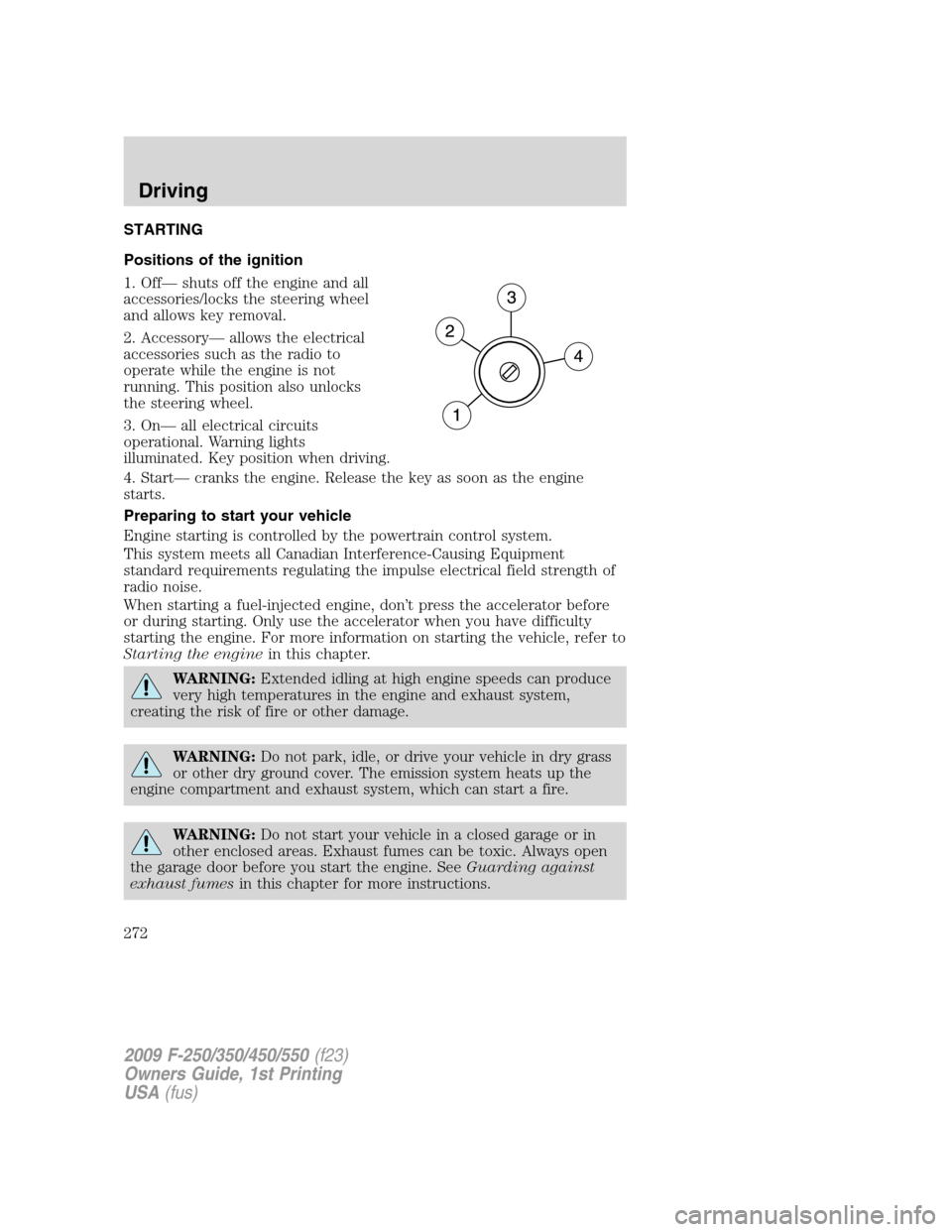
STARTING
Positions of the ignition
1. Off— shuts off the engine and all
accessories/locks the steering wheel
and allows key removal.
2. Accessory— allows the electrical
accessories such as the radio to
operate while the engine is not
running. This position also unlocks
the steering wheel.
3. On— all electrical circuits
operational. Warning lights
illuminated. Key position when driving.
4. Start— cranks the engine. Release the key as soon as the engine
starts.
Preparing to start your vehicle
Engine starting is controlled by the powertrain control system.
This system meets all Canadian Interference-Causing Equipment
standard requirements regulating the impulse electrical field strength of
radio noise.
When starting a fuel-injected engine, don’t press the accelerator before
or during starting. Only use the accelerator when you have difficulty
starting the engine. For more information on starting the vehicle, refer to
Starting the enginein this chapter.
WARNING:Extended idling at high engine speeds can produce
very high temperatures in the engine and exhaust system,
creating the risk of fire or other damage.
WARNING:Do not park, idle, or drive your vehicle in dry grass
or other dry ground cover. The emission system heats up the
engine compartment and exhaust system, which can start a fire.
WARNING:Do not start your vehicle in a closed garage or in
other enclosed areas. Exhaust fumes can be toxic. Always open
the garage door before you start the engine. SeeGuarding against
exhaust fumesin this chapter for more instructions.
2009 F-250/350/450/550(f23)
Owners Guide, 1st Printing
USA(fus)
Driving
272
Page 274 of 418
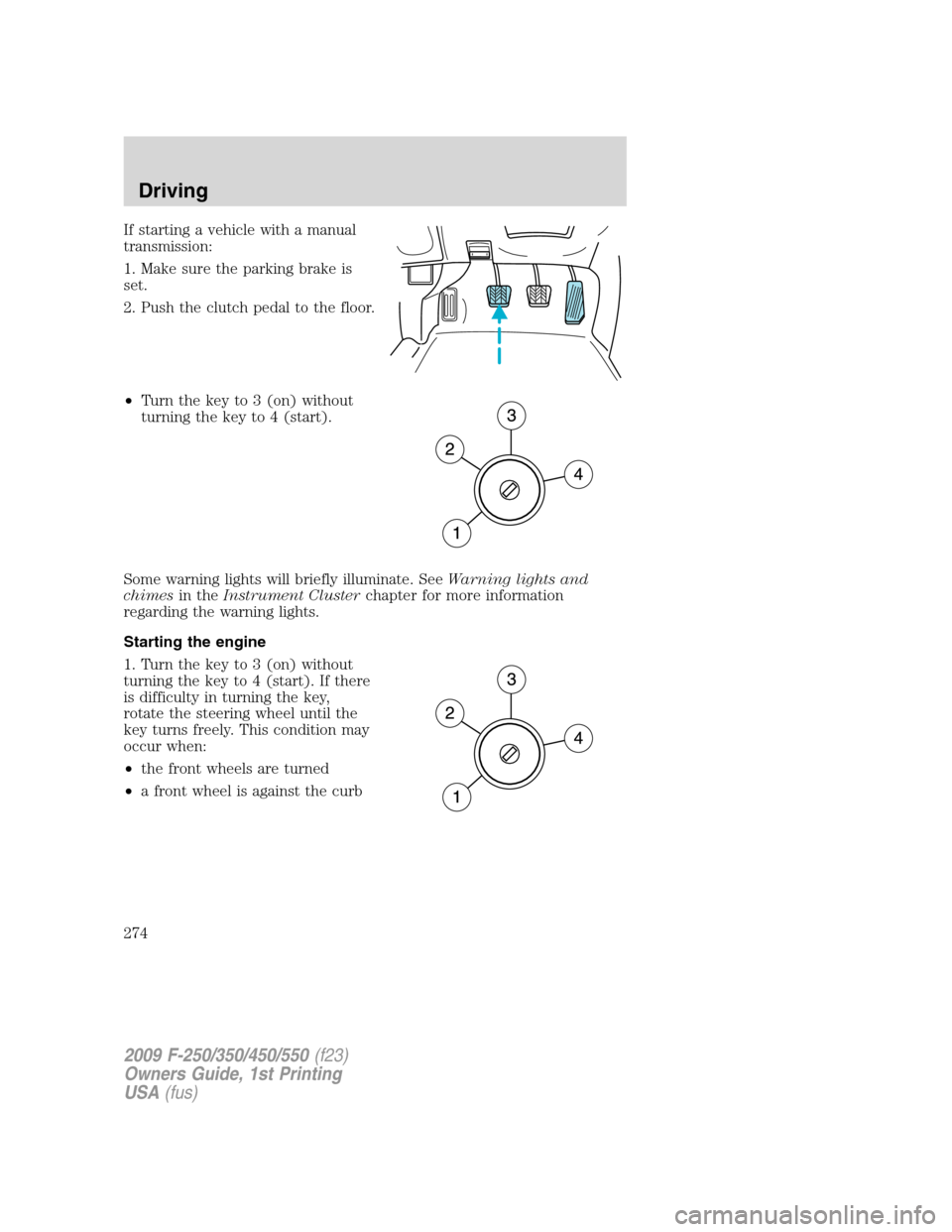
If starting a vehicle with a manual
transmission:
1. Make sure the parking brake is
set.
2. Push the clutch pedal to the floor.
•Turn the key to 3 (on) without
turning the key to 4 (start).
Some warning lights will briefly illuminate. SeeWarning lights and
chimesin theInstrument Clusterchapter for more information
regarding the warning lights.
Starting the engine
1. Turn the key to 3 (on) without
turning the key to 4 (start). If there
is difficulty in turning the key,
rotate the steering wheel until the
key turns freely. This condition may
occur when:
•the front wheels are turned
•a front wheel is against the curb
2009 F-250/350/450/550(f23)
Owners Guide, 1st Printing
USA(fus)
Driving
274
Page 388 of 418
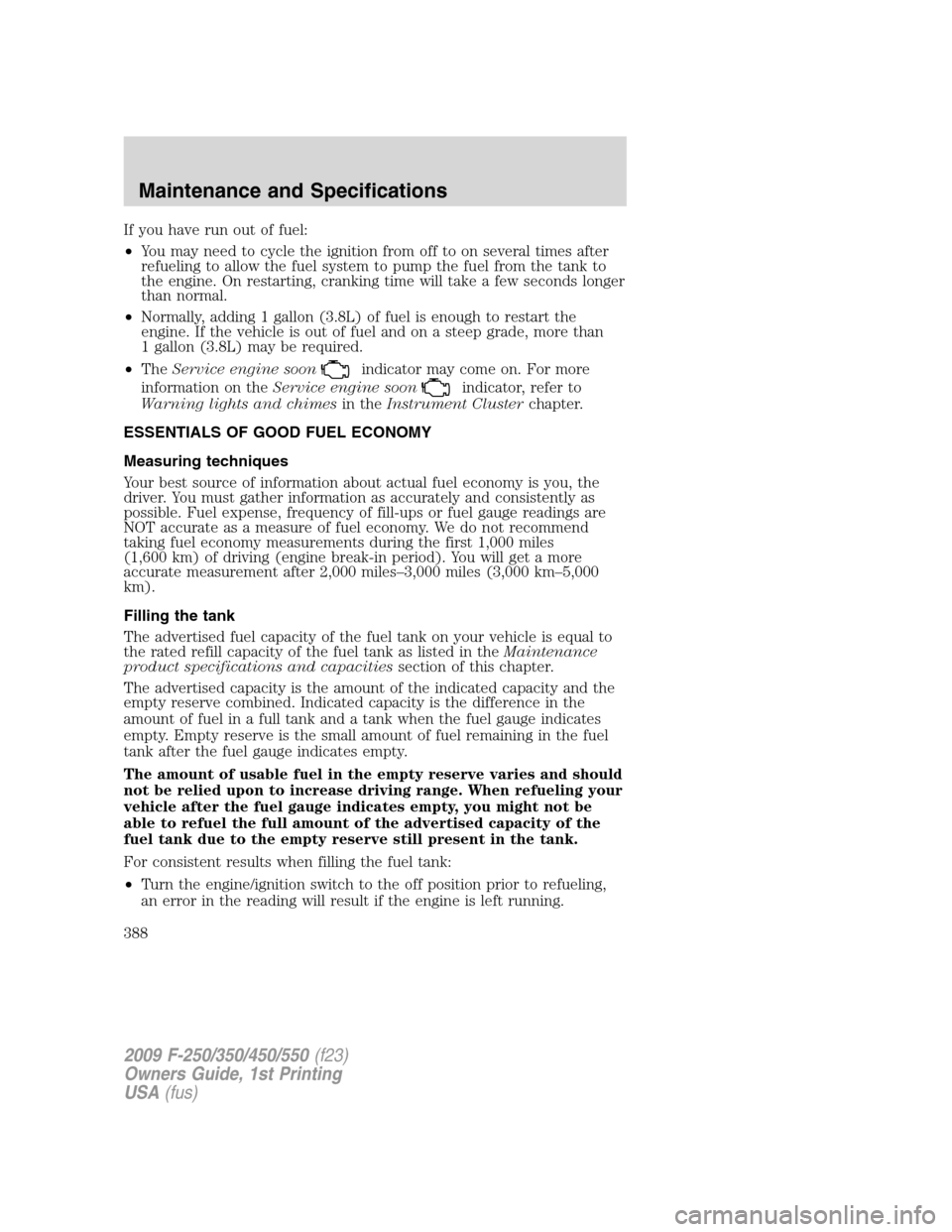
If you have run out of fuel:
•You may need to cycle the ignition from off to on several times after
refueling to allow the fuel system to pump the fuel from the tank to
the engine. On restarting, cranking time will take a few seconds longer
than normal.
•Normally, adding 1 gallon (3.8L) of fuel is enough to restart the
engine. If the vehicle is out of fuel and on a steep grade, more than
1 gallon (3.8L) may be required.
•TheService engine soon
indicator may come on. For more
information on theService engine soon
indicator, refer to
Warning lights and chimesin theInstrument Clusterchapter.
ESSENTIALS OF GOOD FUEL ECONOMY
Measuring techniques
Your best source of information about actual fuel economy is you, the
driver. You must gather information as accurately and consistently as
possible. Fuel expense, frequency of fill-ups or fuel gauge readings are
NOT accurate as a measure of fuel economy. We do not recommend
taking fuel economy measurements during the first 1,000 miles
(1,600 km) of driving (engine break-in period). You will get a more
accurate measurement after 2,000 miles–3,000 miles (3,000 km–5,000
km).
Filling the tank
The advertised fuel capacity of the fuel tank on your vehicle is equal to
the rated refill capacity of the fuel tank as listed in theMaintenance
product specifications and capacitiessection of this chapter.
The advertised capacity is the amount of the indicated capacity and the
empty reserve combined. Indicated capacity is the difference in the
amount of fuel in a full tank and a tank when the fuel gauge indicates
empty. Empty reserve is the small amount of fuel remaining in the fuel
tank after the fuel gauge indicates empty.
The amount of usable fuel in the empty reserve varies and should
not be relied upon to increase driving range. When refueling your
vehicle after the fuel gauge indicates empty, you might not be
able to refuel the full amount of the advertised capacity of the
fuel tank due to the empty reserve still present in the tank.
For consistent results when filling the fuel tank:
•Turn the engine/ignition switch to the off position prior to refueling,
an error in the reading will result if the engine is left running.
2009 F-250/350/450/550(f23)
Owners Guide, 1st Printing
USA(fus)
Maintenance and Specifications
388
Page 416 of 418

Instrument panel
cleaning ...........................361–362
cluster ........................................14
lighting up panel and
interior .......................................91
J
Jump-starting your vehicle ......342
K
Keyless entry system
autolock ...................................154
keypad .....................................164
locking and unlocking doors ..165
programming entry code .......164
Keys ...................................166–167
positions of the ignition .........272
L
Lamps
autolamp system .......................89
daytime running light ...............90
fog lamps ...................................89
headlamps .................................89
headlamps, flash to pass ..........90
instrument panel, dimming .....91
interior lamps ...........................95
replacing bulbs .................97–102
LATCH anchors .........................212
Lights, warning and indicator ....14
anti-lock brakes (ABS) ..........278
Limited-slip axle .......................281
Load limits .................................253
Loading instructions .................259
Locks
autolock ...................................154
childproof ................................157doors ........................................153
Lug nuts ....................................341
Lumbar support, seats .............173
M
Manual transmission .................287
fluid capacities ........................404
reverse .....................................289
Message center .................127, 136
english/metric button .............140
system check button ..............139
warning messages ...........130, 142
Mirrors ...............................110–111
automatic dimming rearview
mirror ......................................110
fold away .........................112, 114
side view mirrors (power) .....111
signal .......................................115
Moon roof ..................................122
Motorcraft parts ................383, 403
N
Navigation system .......................79
O
Octane rating ............................387
Oil (see Engine oil) ..................372
Overdrive ...................................104
P
Parking brake ............................278
Parts (see Motorcraft parts) ....403
Pedals (see Power adjustable
foot pedals) ...............................115
Power adjustable foot pedals ...115
2009 F-250/350/450/550(f23)
Owners Guide, 1st Printing
USA(fus)
Index
416
Page 418 of 418

T
Tailgate ......................................148
Temperature control (see
Climate control) ..........................80
Tilt steering wheel ....................104
Tire Pressure Monitoring
System (TPMS)
Tires, Wheels and Loading ....242
Tires ...................................224–226
alignment ................................234
care ..........................................230
changing ..........................328, 331
checking the pressure ............229
inflating ...................................227
label .........................................241
replacing ..................................232
rotating ....................................235
safety practices .......................234
sidewall information ...............237
snow tires and chains ............252
spare tire .........................326, 328
terminology .............................226
tire grades ...............................225
treadwear ........................225, 231
Towing .......................................259
recreational towing .................271
Trailer Brake
Controller-Integrated ..............264
trailer towing ..........................259
wrecker ....................................347
Traction control ........................279
Trailer Brake
Controller-Integrated ................264
Transfer case
fluid checking .........................400Transmission
automatic operation .......104, 282
brake-shift interlock (BSI) ....282
fluid, checking and adding
(automatic) .............................396
fluid, checking and adding
(manual) .................................399
fluid, refill capacities ..............404
manual operation ....................287
Turn signal ..................................94
U
Upfitter controls .......................121
USB port ......................................44
V
Vehicle Identification Number
(VIN) ..........................................409
Vehicle loading ..........................253
Ventilating your vehicle ...........275
W
Warning lights (see Lights) .......14
Washer fluid ..............................371
Water, Driving through .............309
Windows
power .......................................108
Windshield washer fluid and
wipers ........................................103
checking and adding fluid .....371
replacing wiper blades ...........372
Wrecker towing .........................347
2009 F-250/350/450/550(f23)
Owners Guide, 1st Printing
USA(fus)
Index
418